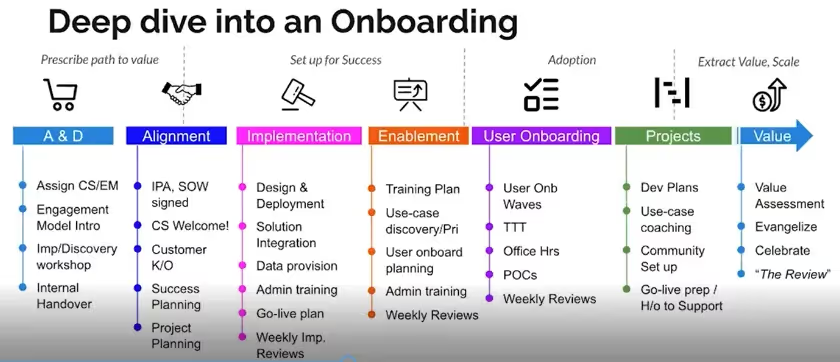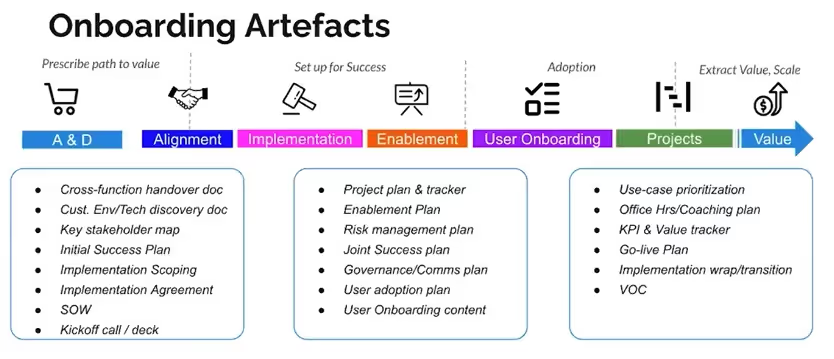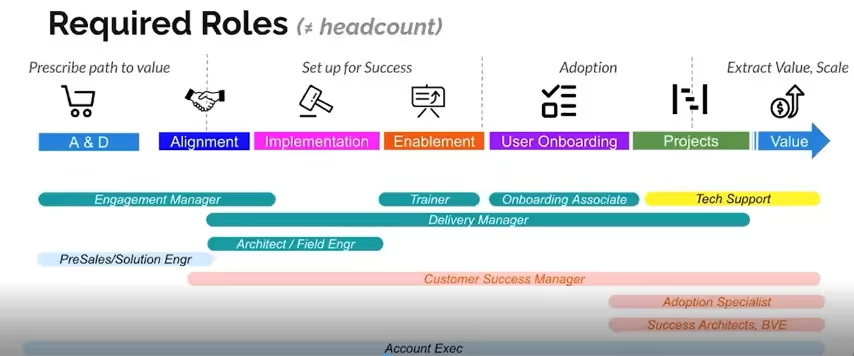In Episode 28 of Implementation Stories, Mahesh Motiramani, Director of Customer Success at Dataiku, shares insights and inputs to help you navigate complicated customer onboarding journeys.
In this session, Mahesh discussed:
- Ways to approach complex and complicated customer onboarding journeys
- Orchestrating successful onboarding: Principles, artifacts, roles/responsibilities
- Tools and metrics to improve the efficiency of customer onboarding
- Success factors and traps to avoid in onboarding
- Principles for scaling and accelerating customer onboarding cycles
Here are key takeaways from the session.
Designing a customer onboarding journey
Remember that onboarding is a customer journey, not just the journey you want them to be on.
Understand what the customer sees as critical, and then design the customer journey instead of imposing your journey on them.
It’s helpful to look at customer onboarding as a combination of two journeys:
1. Setting up
- Implementation/deployment
- Integration
- Approvals (policies and processes)
- Management/scaling/support capabilities
- Resources
2. Generating prescribed value
- Product familiarization
- Enablement
- Quick starts and best practices
- Enablement model
- Prescriptive success journey
Orchestrated onboarding: The solution to handling complicated onboarding journeys
Often, it’s not the product that makes onboarding complicated – it is the effort needed to set it up in the customer’s context and the presence of variables and dependencies at each stage.
The key to navigating this complexity is tightly managing the process to ensure that it positively impacts profitability, employee productivity, and product perception.
Here are some ways to do this:

1. Prescribe the path to value at the start of customer onboarding
- Introduce an Awareness stage to let customers know how you're going to make them successful. Tell them exactly how they need to prepare for onboarding at their end.
- In the Discovery phase, surface the customer’s priorities that will feed into a joint success plan for the next stage.
It’s in these two phases that you need to lock down the scope of the onboarding to build a good joint accountability agreement at the next stage.
2. Set yourself and the customer up for success
- Ensure mutual accountability through a Joint Success Plan (JSP). Your job is NOT to make the customers happy; it is to do the right things for them and get them to do the right thing. A big part of this is change management and project management and ensuring that you lock down the scope of accountability, so you feel comfortable raising issues downstream.
- Solution for the implementation with scope for customization for the customer’s environment.
3. Drive product adoption
- Be prepared to onboard users in waves
- Set up a Center of Excellence (COE) or a Community of Practice (COP) as applicable. A COE is a single centralized team of expert users who will guide and support other users. A COP is a group of users coming together to create best practices for the organization
- Prioritize the right use cases for go-live to clearly define the end of onboarding.
4. Extract value and set up for scale
- Position value-added (VA) services, codevelop use cases, etc.
- As applicable, partner with system integrators, staffing companies, etc., to provide resources and recommendations.
Designing each phase of customer onboarding
Here are the activities and artifacts to include in each phase of onboarding


Roles and responsibilities in customer onboarding
Here are the typical roles associated with orchestrating a complicated onboarding journey (think of these as functions, not necessarily positions to fill):

Best practices for customer onboarding
- The best time to bring the Engagement Manager is at the 50% sale completion stage and the Customer Success Manager is at the 90% stage.
- Ensure that a key responsibility of the sales team is introducing the CS team to the executive sponsor at the customer end.
- Position the CSM role as that of a strategic partner who will stay with the customer for their lifetime and be involved in strategic planning, execution, and multiple streams of value.
To know what other experts have to say about the CSM’s role in customer onboarding, check out:
- Alex Farmer on the role of the CSM in successful customer onboarding
- Jeff Kushmerek on creating specialized customer implementation teams
Tools to support and streamline customer onboarding
Focus on solidifying a process and then incorporating tools that help with it. With any tool, the goal should be to create certainty, visibility, and accountability for every onboarding stage.
Here are a few to consider for onboarding, depending on the stage of your journey.
Startup stage
- Collaboration/documentation suite
- Spreadsheets, forms, docs, etc.
- Video recording and sharing tools
- Communication platforms
- Whiteboarding and diagramming tools
- A CRM
Scaleup stage
- Modern spreadsheet tools, forms, surveys, etc.
- A tool for project management, collaboration, or joint success planning
- Time tracking
- Customer Success Management tool
- Onboarding/adoption tool
- Learning Management Systems
- BI/analytics
- Application integration
Metrics to help navigate complicated customer onboarding journeys
Here are a few metrics that can help you assess the effectiveness and efficiency of the onboarding process.
Time to milestones
- Time to start the deployment (start lag)
- Time to complete implementation
- Time to go from user signup to the user creating value
- First value/impact
- First environment/integration
- First user cohort trained
Project progress
- Burn rate
- Percentage of tasks completed
- Number of risk measures managed
- Number of days to go-live
User metrics
- Number of users trained
- Number of users converted/onboarded
- Number of use cases
- NPS/CSAT
Process and product metrics
- Post-implementation CSAT
- Key product usage metrics
- Number of support requests
6 critical customer onboarding success factors
- Early awareness: Creating early awareness about the prescribed path to value, the engagement model, expectations, service models, staffing requirements, etc.
- Early discovery: Knowing the customer’s goals, requirements, current tech environment/stack, etc.
- A clear first win: Surfacing the value of your solution that a senior executive can prove/acknowledge
- Collaboration: Operating with support not just from internal teams but supporting teams at the customer end, being situationally aware, and partnering with others
- Joint accountability: Having someone accountable at the customer end, having a cadence and mechanism for reviewing each team's accountability and progress.
- Change management: Influencing people and taking them through the change journey, and persuading them to adopt a new way of thinking, a new mindset, and a new way of doing things.
7 customer onboarding traps to avoid
- Gatekeepers: Don’t limit yourself to a few gatekeepers. Go multi-threaded in your communication. Your success depends on multiple people, and you need to be able to communicate with them.
- Missing executive sponsor(s): Don’t start an onboarding project till you have identified a stakeholder on the customer side responsible for keeping their team accountable and the project on track.
- Fake blockers: Blockers often result from a lack of understanding or analysis or the inability to prioritize. Often, they just have upstream issues pushed downstream to a new vendor. Say no to fake blockers.
- Treating each implementation as unique: Standardize early, describe the prescribed implementation path, and stick to it.
80% standardization and 20% environmental variability is a good balance to aim for. - Open-ended or free services: Once you create the ability to charge for your services (after having a way to prescribe a path to value), you avoid the risk of customers assuming that you will provide free services as long as they need you. Closing the boundary in the scope ensures accountability and profitability, besides helping manage expectations.
- Building before the end user is identified or ready: Identify and talk to the end user before investing in a particular diversion or assembly.
- Comfort zones: This applies to your customers’ customer zones as well as yours. All too often, customers want to do things just as they always have – in ways they’re comfortable with. Learn how to get them to move from the current mindset/ process/methodology to a new one.
At your end, push yourself to innovate iteratively–even on things that are working.
7 principles for scaling and accelerating customer onboarding
1. Shift left: Move towards the pre-sales process to engage with the customer so that value appears early. This could be a sample project,
2. Be prescriptive: Standardize implementation with some room for customization. Iterate continuously on an ‘optimal path to value’.
3. Include self-service and automation: Use templates, forms, checklists, and content wherever applicable instead of relying on meetings and workshops for customer participation. Build quickstarts and accelerators so that customers can get to value and accelerate value for you quickly.
4. Drive product maturity to shorten onboarding: Share onboarding feedback with the product to embed capabilities and parts of the user journey into the product.
5. Develop a user community: Invest in setting up a user community to help identify and scale best practices.
6. Measure process efficiency and remove bottlenecks: Periodically, analyze how you fare on process efficiency.
For example:
If you observe a gap between deal signing and deployment because of resource assignment issues, shift left to remove this bottleneck by linking resource requirements to the SOW submission).
If you observe the kickoff meeting (or the preparation for it) to take too long, reimagine what kickoffs look like for you and explore breaking it down into a series of quick meetings, video recordings, etc.
7. Develop your partner ecosystem: Invest in developing your partners’ capabilities, so you can offload heavy-lifting tasks to them and focus on the early set-up-for-success stage for your bigger customer base.



















